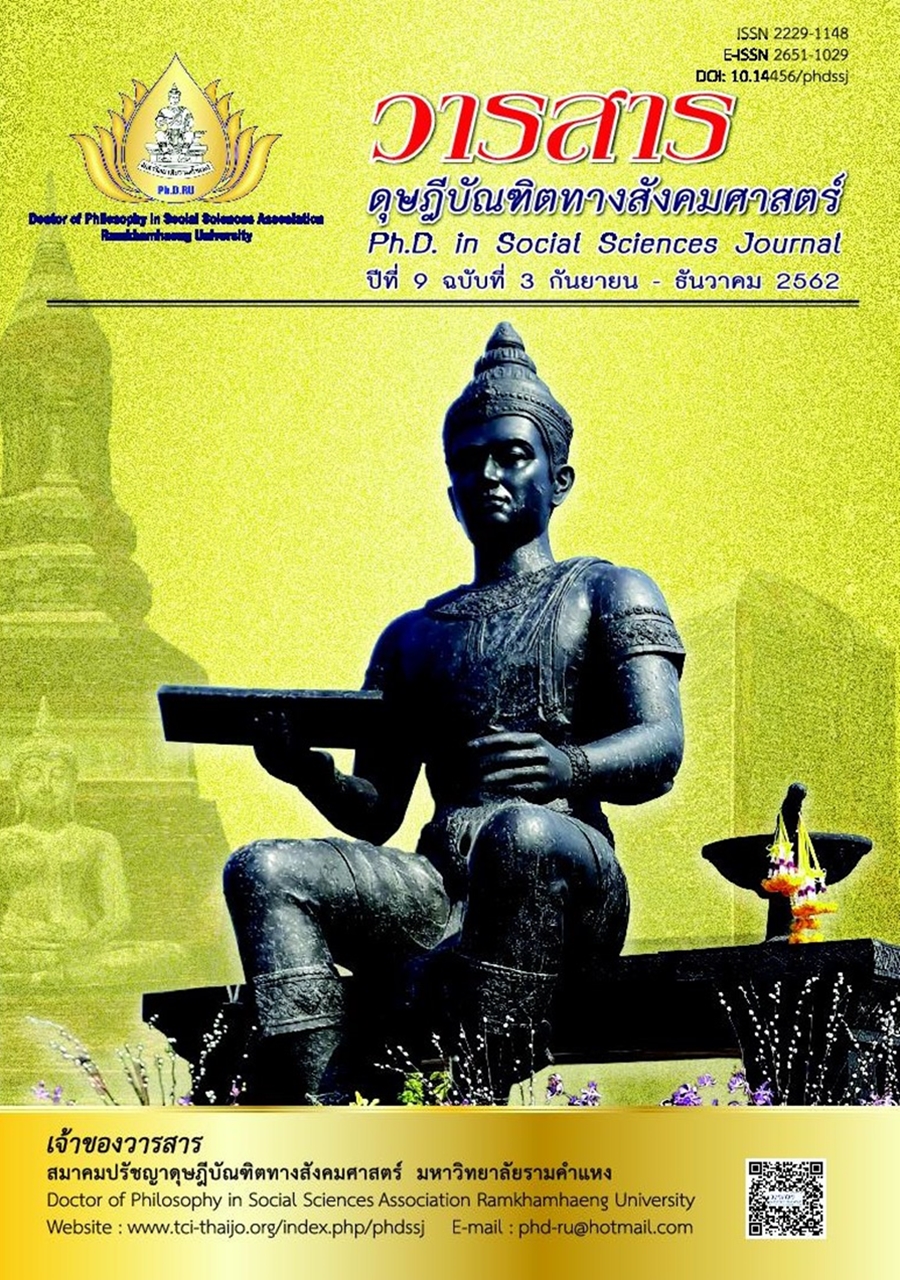Causal Model Development of Customer Based-Brand Equity of Online Travel Agency in Thailand
Main Article Content
Abstract
The objectives of this research were (1) to study the causal factors of customer based-brand equity of online travel agency in Thailand (2) to study the components in the causal factors of customer based-brand equity of online travel agency in Thailand and (3) to develop the causal model of customer based-brand equity of online travel agency in Thailand. A mixed-method combination. Sample sizes equal to 560. The research methodologies were questionnaires and focus group discussions. The statistics used for data analysis consisted of descriptive statistics, correlation coefficient analysis, confirmatory factors analysis, and analysis of structural equation models.
The research results were as follows:
1. the causal factors of customer based-brand equity of online travel agency in Thailand were electronic marketing mixes corporate governance in the customer’s perspective and electronic services quality, these causal factors had a positive direct.
2. the components in the causal factors of customer based-brand equity of online travel agency in Thailand were (1) electronic marketing mixes with the most important was customer service (2) corporate governance in the customer’s perspective with the most important was participation of customers (3) electronic service quality with the most important was contact (4) customer based-brand equity with the most important was brand association (5) customer performance with the most important was customer satisfaction.
3. the causal model development of customer based-brand equity of online travel agency in Thailand passed the fit index criterion for confirmatory factors analysis and structural equation model, The originality found in this research was the model of customer based-brand equity of online travel agency in Thailand.
Article Details
Academic articles, research articles, and book reviews in the Ph.D. in Social Sciences Journal are author’s opinions, and not the publisher’s, and is not the responsibility of the Ph.D. in Social Sciences Journal Philosophy Association, Ramkhamhaeng University. (In the case that research is done on human, the researcher has to be trained in Ethics for Doing Research on Human Training and has to produce the evidence of the training).
References
Browne, M. W., & Cudeck, R. (1993). Alternative ways of assessing model fit. In K. A. Bollen & J. S. Long (Eds), Testing structural equation models. Newbury Park, CA:, Sage.
Cronin, J. J., Brady, M. K., & Hult, G. T. M. (2000). Assessing the effects of quality, value, and customer satisfaction on consumer behavioral intentions in service environments. Journal of Retailing, 76(2), 193-218.
Elsäßer, M., & Wirtz, B. W. (2017). Rational and emotional factors of customer satisfaction and brand loyalty in a business-to-business setting. Journal of Business & Industrial Marketing, 32(1), 138-52.
Gottschalk, S. A., & Mafael, A. (2017). Cutting through the online review jungle--investigating selective eWOM processing. Journal of Interactive Marketing, 37, 89-104.
Hair, J. F., Anderson, R. E., Tatham, R.L, & Black, W.C. (1998). Multivariate data analysis (5th ed.). Upper Saddle River, NJ: Prentice Hall.
Hung, K., Wang, S., & Tang, C. (2015). Understanding the normative expectations of customers toward Buddhism-themed hotels: A revisit of service quality. International Journal of Contemporary Hospitality Management, 27(7), 1409-1441.
Jensen, M. C., & M., W. H. (1976). Theory of the firm: Managerial behavior, agency costs, and structure. Journal of Financial Economics, 3(4), 305-360.
Jeon, M. M., & Jeong, M. (2017). Customers’ perceived website service quality and its effects on e-loyalty. International Journal of Contemporary Hospitality Management, 29(1), 438-457.
Kalyanam, K., & McIntyre, S. (2002). The e-marketing mix: A contribution of the e-tailing wars. Journal of the Academy of Marketing Science, 30(4), 487-499.
Kaplan, R. S., & Norton, D. P. (1992). The balanced scorecard-measures that drive performance. Harvard Business Review, 70(1), 71-79.
Kayaman, R., & Arasli, H. (2007). Customer based brand equity: Evidence from the hotel industry. Managing Service Quality: An International Journal, 17(1), 92-109.
Keller, K. L. (1993). Conceptualizing, measuring, managing customer-based brand equity. Journal of Marketing, 57(1), 1-22.
Kim, W. G., & Park, S. A. (2017). Social media review rating versus traditional customer satisfaction: Which one has more incremental predictive power in explaining hotel performance?. International Journal of Contemporary Hospitality Management, 29(2), 784-802.
Kotler, P., & Armstrong, G. (1997). Marketing: An introduction (Vol. null).
Marsh, H. W., & Hocevar, D. (1985). Application of confirmatory factor analysis to the study of self-concept: First- and higher-order factor models and their invariance across groups. Psychological Bulletin, 97(3), 562-582.
Maxham Iii, J. G. (2001). Service recovery’s influence on consumer satisfaction, positive word-of-mouth, and purchase intentions. Journal of Business Research, 54(1), 11-24.
OECD. (2015). G20/OECD principles of corporate governance. Organization for Economic Cooperation and Development Report to G20 Finance Ministers and Central Bank Governors, 57-59.
Parasuraman, A., Zeithaml, V., and Berry, L. (1988) SERVQUAL: A multiple-item scale for measuring consumer perceptions of service quality, J. Retailing, 64(1), 35-36.
Parasuraman, A., Zeithaml, V. A., & Malhotra, A. (2005). E-S-QUAL: A multiple-item scale for assessing electronic service quality. Journal of Service Research, 7(3), 213-233.
Shampy, K., & Bijoylaxmi, S. (2018). Construction and validation of the customer social participation in brand communities scale. Internet Research, 28(1), 46-73.
Sirawit, S., Nazrul, I., & Do Ba, K. (2011). Does ICT adoption enhance hotel performance?. Journal of Hospitality and Tourism Technology, 2(1), 34-49.
Sun, W., & Price, J. M. (2016). The impact of environmental uncertainty on increasing customer satisfaction through corporate social responsibility. European Journal of Marketing, 50(7/8), 1209-1238.
Tanaka, J. S., & Huba, G. J. (1985). A fit index for covariance structure models under arbitrary GLS estimation. British Journal of Mathematical and Statistical Psychology, 38(2), 197-201.
Uon, V. (2011). Research and information search for business. Bangkok: Sripatum University. [In Thai]
Wang, D. H.-M., Chen, P.-H., Yu, T. H.-K., & Hsiao, C.-Y. (2015). The effects of corporate social responsibility on brand equity and firm performance. Journal of Business Research, 68(11), 2232-2236.
Ye, B. H., Fu, H., & Law, R. (2016). Use of impact-range performance and asymmetry analyses to improve OTA website quality. Journal of Hospitality and Tourism Management, 26, 9-17.


